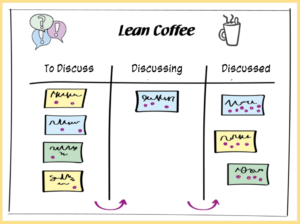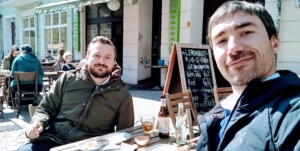We would like to describe a new format and some tools that we used to engage 40 people in an Agile Coffee for 3 hours: it has been an intense moment that gave satisfaction to us as facilitators and to the participants. It presented some significant difficulties and opportunities that we want to share with the community.
Our experience tells us that with a few adjustments this setup could be “scaled” to even more people, up to an Open Space.
A “classic” Lean Coffee
As explained in many articles, podcasts, etc, a Lean Coffee is a structured meeting format that allows you to maximise the time of the participants, focusing on the topics that they feel as to be most relevant, among those generated at the moment. In a nutshell, it’s about generating, sharing and prioritising topics and a series of time-boxed discussions.

A “laced” Lean Coffee to “manage” a long online meeting with many participants
Let’s start with the ingredients, until we understand the pitfalls of the modified context, and then conclude with the procedure to enjoy this excellent coffee.
-
- Slido to collect questions, prioritise and for a “Roman Voting”
- Mural for the “Connection” (see C1 in TBR) at the beginning of the topic
- 1-2 expert facilitators to “manage” the conversations and the mechanics
“It was nice in the post-its era… but now, how does it work remotely?”
The immediacy of writing (and voting!) on a physical post-it is unmatched. There are now many online tools that allow a similar experience e.g. Microsoft Whiteboard, Google Jamboard, Easyretro, Mural, Miro.
Our coffee, however, was longer than usual: up to 3 hours, so we needed a tool where questions could be posted and voted at any time: Slido.

And the Mural (or similar) ingredient stated at the bottom? We used it to keep the audience engaged during conversations. Here is how and why we used live polls and post-its online.
“It’s nice to have a meeting with a structure and without an agenda beforehand but how do you do it when there are so many people?”
In a Lean Coffee, before the prioritisation of the topics there is the collection of the topics and a short presentation for each. We decided to sacrifice the presentation, because having dozens of people taking a few tens of seconds each would take too long.
We use the thumbs up feature to ensure that people discuss the topics of greatest interest.

In a Lean Coffee, at the end of the timebox (usually between 5 and 10 minutes) the participants decide whether to continue to the next topic or to continue for other 5-10 minutes on the same topic. The preference is given with the so-called “Roman Voting”: thumb up means to stay on the same topic, thumb down indicates the preference to go to the next one, horizontal thumb leaves the choice to others. Gathering the preference of the majority is immediate in a face-to-face meeting and can be managed in a videoconference with (few) participants with the camera on. How to get the preference of dozens of people? We used a poll created ad-hoc, activated at the end of the timeboxes and reset immediately after the majority had expressed their preference.

“It’s nice to be in so many … but how to keep everyone engaged?”
Keeping about forty people “on track” is not easy, especially after several time. We therefore borrowed from “Training from the Back of the Room” an activity that allowed the participants to “connect” with every topic at the beginning of the timebox.
After each “launch” of the topic by the person who proposed it, we asked the participants to invest a minute by writing a comment around the topic.
This allowed everyone to be engaged: the post-it notes were not read one by one but were visible to all as suggestions.

Another strategy to keep the participants “connected” during the entire meeting was to allow the topics to be voted on during all moments of the coffee: thanks to tools such Slido, the choice of the next topic was the one with more votes at that moment, which guaranteed everyone to constantly influence the choice.
Conclusions
Thera are ways to have a Lean online Coffee with many people: just pickiing the right tools such as software usually meant for other uses, connection mechanisms coming from cognitive neuroscience and trained facilitators.
Have you ever facilitated or joined a lean coffee with similar characteristics? How did it go? What did you use? In any case, thank you for sharing this special coffee with us!
Diego and Simone

